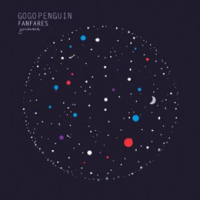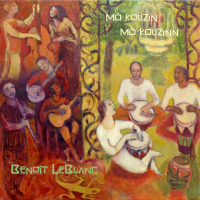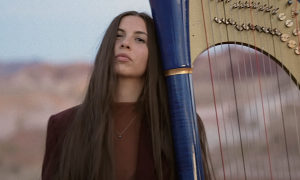Home » Jazz Articles » Interview » Harris Eisenstadt: Full Steam Ahead
Harris Eisenstadt: Full Steam Ahead

All About Jazz: You have three working ensembles: a quintet, a trio and also a new quartet. How do you compose for each ensemble and differ how you play?
Harris Eisenstadt: My primary working group since 2007 has been Canada Day, the quintet. We've released four records (three quintets and an octet version) over the last several years on Clean Feed, Songlines and 482 Music.
My trio is September Trio. Our first record came in out in 2011 and we'll record our second CD at the end of the current tour in Portugal. It will be released in spring, 2013 on Clean Feed.
My third current ensemble is new and doesn't have a name yet. It came about because I'm teaching at Calarts in Southern California in November [2012] and, while I'm out there, I'll do some concerts with [bassoonist] Sara Schoenbeck, [bassist] Mark Dresser and [flautist] Nicole Mitchell. We'll play in Los Angeles and at UC Irvine, do a workshop, and then record for Songlines, which I am looking forward to very much.
The compositions for Canada Day are generally more structured, from section to section, than some of the September Trio pieces, which are more open. There's openness in each group, but generally speaking Canada Day is more structured compositionally. I am not quite sure what the music will be like for the quartet. I've just started sketching the music. Canada Day is perhaps more explicitly groove-oriented. September Trio has a lot of textural, open improvisation and non-metrical moments, but these are generalizations. In terms of timbre, the quartet music will be quite different due to the instrumentation. I've included a flute and bassoon instead of saxophones and brass, which will give things a more chamber music-like vibe. I'm not sure my playing changes from ensemble to ensemble. In each case my goal is to be a sensitive and dynamic accompanist, soloist and ensemble member.
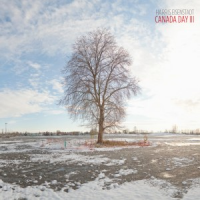 AAJ: Since All About Jazz last spoke to you in 2010, you have taken part in a number of recordings. Is there anything special you remember about each one?
AAJ: Since All About Jazz last spoke to you in 2010, you have taken part in a number of recordings. Is there anything special you remember about each one?AAJ: Jeremiah Cymerman Fire Sign (Tzadik, 2011)
HE: I am on one track on this recording from a concert at Roulette, probably in 2010. It was an ensemble piece with [trumpeter] Nate Wooley, [bassist] Tom Blancarte,[trombonist Sam Kulik, [cellist] Christopher Hoffmanand Jeremiah. I played gongs, vibraphone, floor tom and small percussion. It was a very textural percussion part as I recall. Jeremiah then processed the piece with electronics and the instrumental parts are barely discernible. Typical Cymerman mayhem!
AAJ: Jessica Pavone Army of Strangers (Porter, 2011)
HE: This group worked from 2009-2011, with Jonti Siman on electric bass and first Brandon Seabrook than Pete Fitzpatrick on electric guitar. We recorded at East Side Sound-a studio on the Lower East Side with a great engineer, Marc Urselli. Afterwards, we played at the Saalfelden Festival and that was the last concert for the group. Pete Fitzpatrick moved to northern California and [violist] Jessica Pavone has been working on solo material and playing in a rock band.
AAJ: Harris Eisenstadt September Trio (Clean Feed, 2011)
HE: This is with [saxophonist] Ellery Eskelin and [pianist] Angelica Sanchez. We first played an improvised first at (saxophonist/composer John Zorn's New York City club) The Stone some years ago...2009, I think, which went very nicely. Pedro Costa from Clean Feed then invited us to play again when he was asked to curate The Stone in summer, 2010. I decided to make the trio my group and write for us. We recorded six months or a year later. We rehearsed, played a couple of concerts than went into Systems Two and made the record in six hours.
AAJ: Nate Wooley Quintet (Put Your) Hands Together (Clean Feed, 2011)
HE: This band has been really a joy and a constant in my sideman activities for three or four years. Nate is a close musical and personal compatriot and one of my most simpatico musical colleagues. We recorded this album at (Brooklyn's) Systems Two and it came out on Clean Feed. We are getting ready to record his next one for Clean Feed in December. We'll do a four-night residency at Douglass Street Music Collective and then go into Water Music (Hoboken, NJ), the studio where we recorded Canada Day III and [clarinetist] François Houle 5+1's Genera.
AAJ: Francois Houle 5 + 1 Genera (Songlines, 2012)
HE: The story behind this recording is crazy. Francois and Benoit Delbecq (the pianist in the band) were playing in Quebec City the night before the recording. They were scheduled to fly down to New York to record the morning of the session and Air Canada went on strike. They rented a car and drove 9-10 hours to New Jersey to the studio, got out of the car and we rehearsed as a group for the first time... then we recorded until 2:00 am. They got up at 5.00am and drove back to Montreal to fly back to Vancouver and Paris! All things considered, the music came out great. We toured the Canadian festivals this past summer and really took the music to another level. We have a couple gigs in New York this fall and hopefully some more stuff next year.
AAJ: In addition to a busy recording schedule, you have accepted a commission to write a community piece for the Brooklyn Conservatory orchestra. How will you compose music for both experienced musicians and kids?
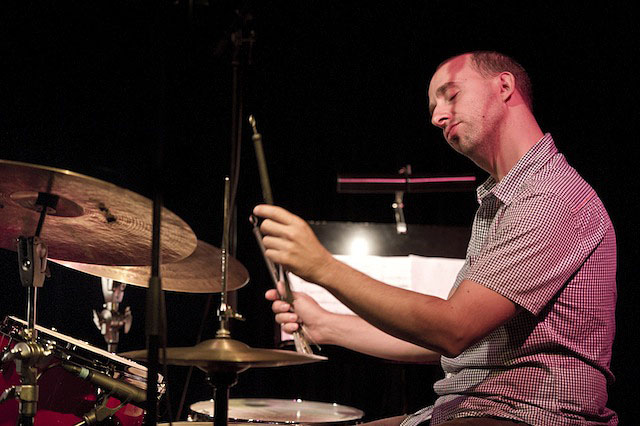
HE: I'm not sure yet. When I get back from the current tour I have a meeting with the conductor of the orchestra, who has drawn up a letter of agreement. We'll fine tune it, sign off on it, and I'll get to work. First of all, it's the Brooklyn Conservatory Community Orchestra, so I have to ascertain the various playing levels within the orchestra. The student drummers will be, for the most part, beginners, so I have to address how technically demanding the material can be. The other thing is how to integrate beginner drummers into a piece for orchestra. This will be a challenge not only as far as the varying skill sets are concerned, but also as far as how to meaningfully integrate two very disparate sonic environments, both dynamically and material-wise. What I know I do not want to do is have it be orchestral passage-pause-students play some African Diaspora- derived drum line stuff-pause-go back to the orchestra. I want to avoid that kind of back-and-forth thing. There's a lot to think about. The premier is scheduled for fall 2013, so I have a year to figure it out.
AAJ: You teach at two State University of New York campuses. What do you aim to achieve through your teaching? Do you find teaching enriches or influences your compositions in any way? HE: I'm teaching mostly at one SUNY campus: the Maritime College in the Bronx. I teach three classes per semester as an adjunct professor. One great thing about being adjunct faculty at SUNY is that I get health benefits for my family and I. I'm adjunct at one other SUNY campus (Empire State College). I teach mostly independent studies there, usually online. At Maritime, I teach non-majors in the humanities department and can only offer one music class per semester, so I teach Western Music in the fall and World Music in the spring. The other two courses each semester are both Freshman English Composition. I was an English major, Music minor as an undergraduate, so it works out. I've also worked for several arts education organizations over the years in LA and New York as a teaching artist. Currently, I work for 92 Street Y and the Brooklyn Academy of Music in addition to my adjunct work at SUNY. I teach mostly drumming and world music for these organizations. They send me into NYC public schools, from elementary through high school.
As a teacher I aim to connect with my students, whether they are in kindergarten or college. I aim to instill a respect for, appreciation of and (if possible) a love for the arts- whether it's African rhythms with first-graders, literature in my freshman English classes, or music that my upperclassmen have never heard. I'm not sure that my teaching influences my compositions in any way, but it certainly enriches my life and contributes artistic inspiration.
AAJ: You recently premiered your first piece for orchestra, "Palimpsest," with the American Composers Orchestra. Which concepts did you explore and how different is it composing for an orchestra to your usual small group work?
HE: It was a wonderful experience. I felt very fortunate to sit in the audience as the orchestra rehearsed and then read my piece. That was the first major difference-not being involved as a performer. Even though the premise of the program was to see/hear how several different jazz composers integrated improvisation into orchestral composition, I didn't actually include any space for improvisation. We had very little rehearsal time and I wanted to make the most of the opportunity to write for some seriously high-level interpreters of notated music. So the nature of the ensemble and the parameters for rehearsal/performance were completely different than writing for jazz ensemble.
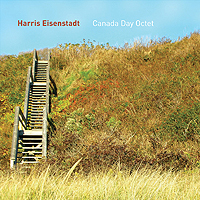 I titled the piece "Palimpsest" because I spent almost a year revising, writing then erasing, adding material and refining it, as one does with text on a palimpsest. The first draft of the piece was completed in September 2010 and the piece was read in summer 2011. So, from September to April (when I had to turn in the score and parts) I revised obsessively. That is completely different for me than preparing a book of music for an improvising group, in which an ensemble shapes the pieces in rehearsal and on the bandstand. The idea that materials from a palimpsest can be used again and again resonated with me because it's literally what happened. Many of the preliminary sketches (and even some of the final materials) ended up being morphed and used in different ways for other compositions since that orchestral work.
I titled the piece "Palimpsest" because I spent almost a year revising, writing then erasing, adding material and refining it, as one does with text on a palimpsest. The first draft of the piece was completed in September 2010 and the piece was read in summer 2011. So, from September to April (when I had to turn in the score and parts) I revised obsessively. That is completely different for me than preparing a book of music for an improvising group, in which an ensemble shapes the pieces in rehearsal and on the bandstand. The idea that materials from a palimpsest can be used again and again resonated with me because it's literally what happened. Many of the preliminary sketches (and even some of the final materials) ended up being morphed and used in different ways for other compositions since that orchestral work.AAJ: Your Drumming Connectivity initiative is now up and running. How did you come up with the concept and what does you aim to achieve with these group drumming sessions?
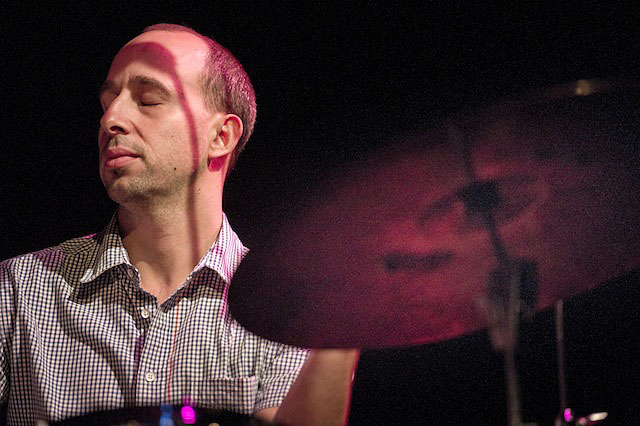
HE: The drum circles for corporate and community organizations have grown out of my work as a teaching artist for arts organizations. It's amazing to see how a group of middle-aged CEOs contends with a version of the same materials as a group of eight year-olds. In either case, there are valuable lessons in ensemble drumming to be learned that translate to how we interact with each other in daily life, in the workplace, in the classroom, or anywhere, really. Working on listening and responding thoughtfully to each other is a valuable exercise for any age. I look forward to continuing this kind of work with groups of all different ages and backgrounds. I have to spend some more time finding creative ways to market these workshops. Just having a comprehensive website isn't enough, but it's a start.
AAJ: How do you find time to juggle an extraordinary number of projects: three active ensembles, recording with other groups, teaching, a young family and also your wife Sara's career as a bassoonist?
HE: It's very difficult to make sure that a part of each day is used for each of the creative outlets that need to be serviced. There have been times in my life when I composed many hours every day, practiced many hours of each day, dealt with music business every day, but to do that forever is just not possible. Not to mention the moneymaking thing that everyone has to deal with. When you're an artist for a living, so to speak, that means you make money as you can and from a number of different things. There are people who do all kinds of things to pay their bills. For me it means I teach a lot in addition to tours and recordings.
There are days when I get home and just want to collapse on the couch, play with my son and hang out with my wife; days like that when I don't compose at all and don't practice. There are days when I come back from a full day of teaching and hang out with my kid, hang out with my wife and also find time to practice and compose, and there are days when I don't have teaching commitments and have all the time in the world to practice and write. Now that my son is at pre-school three mornings a week, if my wife Sara is practicing, doing what she's doing, and I have some time, I try to seize it and practice and compose and take care of business. It is a real balancing act to get as much done as you can in these windows of free time.
It would be different if I weren't in a relationship, if I didn't have a child, if I was in a situation where I didn't have to earn income for a family of three. If I had time to just practice, just write all day, just take of business, than I would do that; but I feel very lucky to have a wife and child that I love being with, and to be able to find the time to keep working on music, writing, practicing, performing. Sara is also a musician, and that means we have unorthodox schedules. A lot of Sara's work is in the classical and new music worlds (as well as jazz and improvised music) and that means she has to put a great deal of time into preparing for performances. Our artist careers mean that there isn't really a typical day... every day is different!
Selected Discography
Harris Eisenstadt, Canada Day III (Songlines, 2012)
Harris Eisenstadt, Canada Day Octet (482 Music, 2012)
Harris Eisenstadt, Canada Day II (Songlines, 2011)
Harris Eisenstadt, September Trio (Clean Feed, 2011)
Harris Eisenstadt, Canada Day III (Songlines, 2012)
Harris Eisenstadt, Woodblock Prints (No Business, 2010)
Harris Eisenstadt, Canada Day (Clean Feed, 2009)
Harris Eisenstadt, Guewel (Clean Feed, 2008)
Photo Credit
Page 1: Courtesy of Harris Eisenstadt
All Other Photos: Ziga Koritnik
Tags
Harris Eisenstadt
Interview
James Pearse
Canada
Toronto
Bill Frisell
Chick Corea
Sara Schoenbeck
Mark Dresser
Nicole Mitchell
Jeremiah Cymerman
nate wooley
Tom Blancarte
Sam Kulik
Chris Hoffman
Jessica Pavone
Jonti Siman
Brandon Seabrook
Ellery Eskelin
Angelica Sanchez
john zorn
Francois Houle
Benoit Delbecq
PREVIOUS / NEXT
Support All About Jazz
 All About Jazz has been a pillar of jazz since 1995, championing it as an art form and, more importantly, supporting the musicians who make it. Our enduring commitment has made "AAJ" one of the most culturally important websites of its kind, read by hundreds of thousands of fans, musicians and industry figures every month.
All About Jazz has been a pillar of jazz since 1995, championing it as an art form and, more importantly, supporting the musicians who make it. Our enduring commitment has made "AAJ" one of the most culturally important websites of its kind, read by hundreds of thousands of fans, musicians and industry figures every month.



